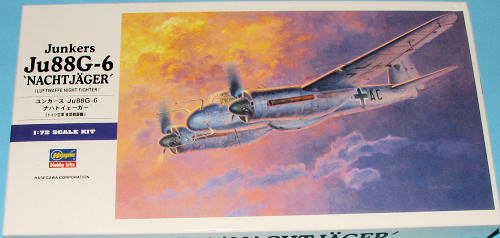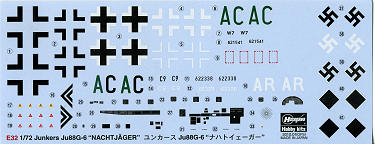
Hasegawa 1/72 Ju-88G-6 'Nachtjäger'
| KIT #: | 01562 |
| PRICE: | $52.00 MSRP ($44.75 at GreatModels) |
| DECALS: | Three options |
| REVIEWER: | Scott Van Aken |
| NOTES: | Base kit |

| HISTORY |
Hopefully, most of you will know that the Ju-88 was probably one of the most widely adapted German twin engine medium bombers of WWII. One area where they were widely used in the last years of the conflict was as a night fighter.
All previous night fighter versions of the Ju 88 prior to this series used a modified A-series fuselage. The G-series fuselage was purpose-built for the special needs of a night fighter, with the A-series' Bola ventral under-nose defensive gun position omitted for lower aerodynamic drag and less weight. G-1 aircraft were fitted with the enlarged squared-off vertical fin/rudder tail unit of the Ju 188, more powerful armament and 1,700 PS BMW 801 G-2 radial engines plus additional FuG 350 Naxos or FuG 227 Flensburg homing devices as well as the now-standard FuG 220 Lichtenstein SN-2 90 MHz VHF radar.
G-6 versions (and the subject of this kit) were equipped with 1,750 PS Jumo 213A inline-V12 engines, enlarged fuel tanks and often one or two 20 mm MG 151/20 cannons in a Schräge Musik ("Jazz Music", i.e. slanted) installation. Guns were firing obliquely upwards and forwards from the upper fuselage - usually at an angle of 70°.
Some of the final G-series models received updates to the engine, a high-altitude Jumo 213E or to the radar, FuG 218 Neptun V/R or the even newer FuG 240 Berlin N-1 cavity magnetron based, 30 GHz-band (centimetric) radar. Only about 10-20 of those were completed before V-E Day.
Many Luftwaffe night fighter aces, such as Helmut Lent (110 victories) and Heinrich von und zu Sayn-Wittgenstein (87 victories) flew Ju 88s during their careers.
Those wanting to know more would be advised to click on the reference link.
| THE KIT |
 It
is a surprise to absolutely no one that Hasegawa would release a G-6 night
fighter version after having issued the G-1 variant earlier. In fact, from the
look of the sprues, the BMW engines of the G-1 version are included so those who
had a change of heart after buying this kit may well be able to do the earlier
variant, though decals may be an issue.
It
is a surprise to absolutely no one that Hasegawa would release a G-6 night
fighter version after having issued the G-1 variant earlier. In fact, from the
look of the sprues, the BMW engines of the G-1 version are included so those who
had a change of heart after buying this kit may well be able to do the earlier
variant, though decals may be an issue.
Anyway, modern kits are very much an exercise in doing multiple variants and Hasegawa has that aspect of things down pat. The kit is very nicely detailed with engraved detailing and on the inside, some nicely done detail as well, though Hasegawa still relies on decals for instrument panels. However, all the various boxes and bits are included with nicely raised detail. The modular fuselage is still in sections with separate nose and fuselage. The kit includes some hefty wing spars to help hold on the wings.
The engine cowlings are nicely done with optional open and closed cowl flaps. Also nicely done are the rather complex landing gear parts, which, unlike some other kits, can be installed at the end of the build to keep them intact. There are a variety of different radar antenna systems included that will differ depending on which of the markings options is chosen. This also extends to optional canopy bits and optional placement of the upward firing cannon. In fact, you'll have to decide very early in the build just what option you want to build as some parts need trimmed and others need specific holes opened.
 Instructions
are very well done with all these little modifications clearly shown. The usual
Gunze paint references are used, though so are RLM numbers where applicable.
Three different markings options are provided, all based on overall RLM 76. The
first aircraft as shown on the box art is from Stab II./NJG 100 during 1944/45.
This has a medium mottle of RLM 75. The next is similarly painted and has the
same aircraft number. The mottling on this one is a bit heavier. The aircraft
was flown by II./NJG 5 Kommandeur, Major Hans Leickhardt at the end of 1944. The
final option is very heavily mottled on the upper surfaces with a base coat of
RLM 82 and the mottling in RLM 81. This aircraft was assigned to 7./NJG 5 in
April of 1945. Decals are nicely printed and should provide no problems. I
notice that a black square is provided for those places that don't allow display
of the swastika.
Instructions
are very well done with all these little modifications clearly shown. The usual
Gunze paint references are used, though so are RLM numbers where applicable.
Three different markings options are provided, all based on overall RLM 76. The
first aircraft as shown on the box art is from Stab II./NJG 100 during 1944/45.
This has a medium mottle of RLM 75. The next is similarly painted and has the
same aircraft number. The mottling on this one is a bit heavier. The aircraft
was flown by II./NJG 5 Kommandeur, Major Hans Leickhardt at the end of 1944. The
final option is very heavily mottled on the upper surfaces with a base coat of
RLM 82 and the mottling in RLM 81. This aircraft was assigned to 7./NJG 5 in
April of 1945. Decals are nicely printed and should provide no problems. I
notice that a black square is provided for those places that don't allow display
of the swastika.
| CONCLUSIONS |
Another very nice addition to the growing Hasegawa Ju-88 line. I'd say this makes all other 1/72 Ju-88 kits obsolete, but that might seem redundant.
| REFERENCES |
http://en.wikipedia.org/wiki/Ju88
April 2010
You can find this and many other neat kits and accessories at
GreatModels
If you would like your product reviewed fairly and quickly, please contact me or see other details in the Note to Contributors.